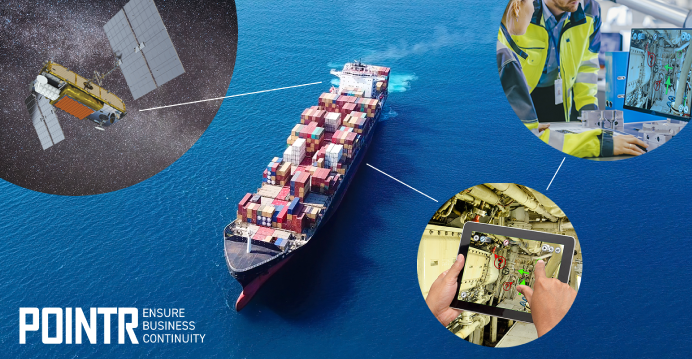VSAT video call – enabling remote support for maritime

Can you make VOIP video calls through satellite network? How about VSAT video call? Can you use modern augmented reality video (AR video) tools for remote technical support for your vessels on the sea? Can you trust, that the connection will work? The answer is yes. These issues were studied in a joint project with European Space Agency, Wärtsilä, Valmet, Kone and Delta Cygni Labs.
Terrestrial mobile (4G) and VSAT C-band are trending in maritime
For VSAT the main improvement has been the introduction of C-band connectivity. It offers a true high speed internet access for ships.The high speed internet access is not only for operating the ship, but for bringing comfort and safety to the crew and passengers as well. On top of the VSAT satellite connectivity, 4G/LTE technology with a directed antenna setup is raising interest among offshore companies. This network technology development open new opportunities for offshore VSAT video call.
VSAT will remain number one communication link for ”deep sea” connectivity at the moment. But whenever possible, shipping companies will utilise 4G/LTE communication in parallel. Main driver for 4G/LTE is the cost and bandwidth of VSAT. According to different sources (Bluewireless, 2018/2019) 4G network can be utilized up to 70km out from shore.
POINTR VSAT video call onboard testing
In the previous article we discussed briefly the problems of remote maintenance and real time remote collaboration in offshore environment. In this article we will have a look at the network parameters and performance offshore. We will also give some details about POINTR tests on different locations and vessels globally.
In total we tested POINTR using satellite connectivity with over 100 users from over 25 locations around the world. During the test period we made up to 500 calls successfully. Calls were made from functioning vessels to shore and from land to vessels offshore. Call endpoints during the testing period included Europe, South America, Mexico, US, South Africa, Japan, China, Singapore, Australia and South-Korea.
Learnings from the test
Performance:
The results from the testing were positive. POINTR worked well in typical conditions on vessels. We found out that It can handle and maintain calls when the connectivity conditions are poor. Lowest bandwidth we could run POINTR VOIP video calls was 128kbit/s and the call survived long latencies and big variance in latencies. All conditions, which are typical for satellite connections.
Findings – POINTR works well in typical conditions with any of the given conditions. And even in L-Band VSAT as backup. 128kbit/s and 1000ms latency will still be enough to maintain the video call.
The ideal bandwidth would be 500kbit/s, where the operations are smooth and nice, but on sea you cannot trust to have these conditions.

Use cases and usability:
We collected as well a lot of feedback related to usability. Usability of the app itself, different hardware and the overall use cases. Simplicity and robustness being the main takeaway from usability perspective. This applies to hardware and software. We will write more about usability in a separate posting. Use cases what can be seen are typically maintenance related. But surprisingly wide scope, all what is on board has to be maintained. More on the use cases as well on a separate posting later.
POINTR design principles
Pointr has been designed for challenging conditions. Our first customer project was European Space Agency ESA, the maintenance of International Space Station Columbus module. Our design targets came from there: we need to be able overcome following challenges:
- Manage high latency up to 1000ms,
- Manage latency variance up to 540ms
- Manage bandwidth (up/down) from 128kb/sec
- Scale automatically the call to match to conditions, without breaks
- Single image quality always high
In order to do this, we developed our own telecommunication protocol. which has proven to be not only very efficient but as well secure. More about the security part in another posting.
Pointsat project – VSAT video call to new level
Target of Pointsat project was to analyse, how to enable remote maintenance and support for critical missions through satellite networks. Project was done in co-operation with European Space Agency ESA PointSat project. In PointSat project, our customers Valmet, KONE Marine and Wärtsilä performed extensive POINTR pilots in the maritime environment across 18 countries and showcased POINTR VSAT video call to a number of their customers in maritime sector.